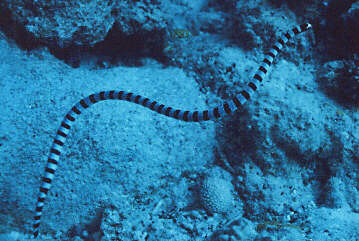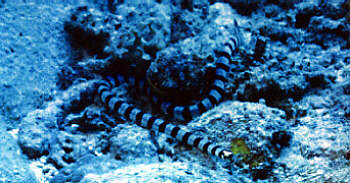Yellow-lipped sea snake
Laticauda colubrina
Philippa Mantel, 1999

Authority: Schneider, 1799
Common Name: Laticauda colubrina has several common names. It is referred to as the large-scaled sea krait because of the presence of an extra median scale between the eyes on the posterior snout, yellow-lipped sea krait because of the yellow upper lips, and sometimes as the banded sea krait because of the numerous black bands covering the body.
Description (Cadle and Gorman 1981; Coborn 1991; Shine 1998; Gorman et al. 1981; Heatwole 1999; Cogger 1994; Ehmann 1992):
Laticauda colubrina is a member of the only genus of oviparous sea snakes. They spends considerable time on land where they lay their eggs and have therefore retained a cylindrical body shape and have developed ventral scales like typical terrestrial snakes which aid in climbing on land and in low trees. They are, however, well adapted for an aquatic existence with a laterally compressed tail similar to that of viviparous sea snakes (Hydrophiids), which allows rapid movement in the water.
They also have large lungs which allow them to spend longer periods of time underwater, valvular nostrils to keep saltwater out when diving, and specialised glands under the tongue for salt excretion. Smooth body scales, base colour blue or blue-grey with 20-65 black bands which usually encircle the body. Ventral surface is yellow or cream. Snout, upper lips and a small bar above the eye are yellow. Remainder of head is black. Short, cobra-like head with venom fangs located at the front of the upper jaw. L. colubrina is a highly sexually dimorphic species with females growing up to one-third larger than males.
Adult males grow up to 75cm whereas an adult female can reach 128cm in length.
Maximum length recorded: 360cm.
Similar species (Pernetta 1977):
Yellow-lipped sea snake is most easily confused with Laticauda Laticaudata (Banded amphibious sea snake) from which it can be distinguised by the fact that it has 21 or more scale rows at mid-body (vs 19). They also resemble the terrestrial, banded Asian species of the genus Bungarus.
Range (Heatwole 1978; Cogger 1994; Shine 1998):
The range of L. colubrina and other sea kraits is more limited than that of true sea snakes (Hydrophiids). They have a wide distribution through the Pacific and have occasionally been recorded from tropical and temperate coasts of Australia. However, no resident populations have been found in this country.
Ecology and behaviour (Shine 1998; Heatwole 1999; Cogger 1994; Ehmann 1992; Seigel and Collins 1993; Pernetta 1977):

Yellow-lipped sea snake are truly marine but have a terrestrial mode of reproduction. They inhabit shallow tropical seas surrounding small coral islands, coral reefs and mangroves, usually with a sand or coral substrate. They are found at depths ranging between 1-10m. The reason for this is mainly because of the low permeability of the skin, which could be dangerous below these depths. Laticauda colubrina are mostly nocturnal and primarily move between land and ocean during this time but have also been found foraging during the day. They move over large areas of the reef in search for food. Main prey item is eel but they have also been observed feeding on small fish such as gobies. They trap their prey in coral crevices using coils of their body. Yellow-lipped sea snake show sex-based ecological divergence. For example, males being the smaller sex usually forage in shallower water than females and also tend to prey on different kinds of eels, than do their mates. Males take smaller, reef-flat eels whereas females prey on larger eels
in waters close to the reef. Despite being a marine species, they seem to prefer freshwater to seawater and have been seen drinking rainwater from puddles on the ground and from depressions in leaves. They shed their skin either on land or in the sea. They have highly toxic venom, however due to their inoffensive nature they seldom bite, even in selfdefence.
Breeding biology (Cogger 1994; Pernetta 1977; Shine 1998; Ehmann 1992; Heatwole 1999; Seigel et al. 1987):
The reproductive biology of L. colubrina and other species of the family Laticaudinae are different from all other sea snakes. They are oviparous and need to come ashore on small isolated islands to lay their eggs. Large aggregations form at these breeding and resting sites. L. colubrina undertake long distance migrations for breeding. Males reach sexual maturity at about 18 months whereas females can take up to 24 months before they are ready to breed. Clutch sizes tend to be large but may vary geographically, with smaller clutch sizes in some areas and larger in others. A female can lay 4-20 eggs at any time of the year. The populations of L. colubrina have smaller numbers of juveniles than adults, which is most likely a result of low fecundity and high juvenile mortality.
Literature cited:
- Cadle, J.E. and Gorman, G.C. 1981. Albumin Immunological Evidence and the Relationships of Sea Snakes. Journal of Herpetology 15(3):329-334.
- Coborn, J. 1991. Atlas of snakes of the world. T.F.H. Publications Inc, USA.
- Cogger, H.G. 1994. Reptiles and Amphibians of Australia. Reed Books, Chatswood, NSW.
- Gorman, G.C., Licht, P. and McCollum, F. 1981. Annual Reproductive Patterns in Three Species of Marine Snakes from the Central Philippines. Journal of Herpetology 15(3):335-354.
- Ehmann, H. 1992. Encyclopedia of Australian Animals: Reptiles. Harper Collins Publishers, NSW.
- Heatwole, H. 1978. Adaptations of Marine Snakes. American Scientist 66:594-604.
- Heatwole, H. 1999. Sea Snakes. University of New South Wales Press Ltd, Australia.
- Pernetta, J.C. 1977. Observations on the habits and morphology of the sea snake Laticauda colubrina (Schneider) in Fiji. Canadian Journal of Zoology 55:1612-1619.
- Seigel, R.A., Collins, J.T. and Novak, S.S. 1987. Snakes. Ecology and Evolutionary Biology. McGraw-Hill Inc, New York.
- Seigel, R.A. and Collins, J.T. 1993. Snakes. Ecology and Behaviour. McGraw-Hill Inc, New York.
- Shine, R. 1998. Australian Snakes: a natural history. Reed Books, Sydney.
